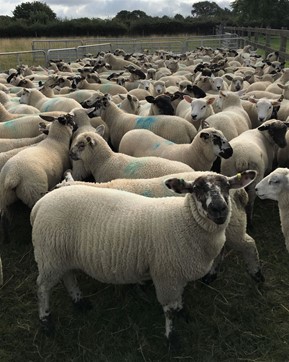Weight adjusted traits
 One of the challenges in assessing carcase traits in sheep is determining a suitable end point for comparison to be made between individuals. Should we compare carcase attributes at a fixed age, weight or level of finish?
One of the challenges in assessing carcase traits in sheep is determining a suitable end point for comparison to be made between individuals. Should we compare carcase attributes at a fixed age, weight or level of finish?
Historically carcase traits have been adjusted for age, however this means that increases in muscling are confounded with growth rate. The bigger sheep, unsurprisingly, tend to have larger muscles at a fixed age.
In the UK, whilst lamb growth rate is important (and EBVs for this trait are readily available), lambs tend to be slaughtered at a fixed weight (and ideally a similar level of finish). For this reason, Signet changed the terminal sire evaluation to incorporate weight adjusted carcase traits that would highlight differences in lambs killed at a similar slaughter weight.
As can be seen in the table below, when traits are assessed on a fixed weight basis the heritability values typically increase, but the overall variation in the trait (both environmental and genetic) reduces.
It is also important to note that the genetic relationship between carcase traits changes when they are adjusted in a different manner. When age adjusted, there tends to be a positive correlation between the amount of muscle and fat in the carcase - as selection is simply leading to bigger animals with more of both tissues.
When assessed on a weight adjusted basis, a negative correlation can develop - as those animals with more muscle in the carcase at a fixed weight, tend to be leaner. This negative relationship can prove challenging to manage when the overall breeding objective is to increasing muscling, but ensure an optimum amount of fat is retained on the carcase at a constant weight.
Table 1. Genetic parameters for ultrasound traits for numerically large Signet recorded breeds.
Data taken from two pieces of AHDB funded research
- Texel (129,103 records), Charollais (64727 records) and Suffolk (92435 records) completed by McLaren 2017. Genetic analyses of novel traits derived from CT scanning for implementation in terminal sire breeding programmes. AHDB Reference: 61100029. Final report 7th July 2017
- Lleyn (64,831 records) and Meatlinc (23499 records) completed by Roden 2016
|
|
|
Genetic Variance, VA |
Heritability, h2 |
Genetic Variance, VA |
Heritability, h2 |
|
Texel |
Scan Weight |
9.71 |
0.32 (0.01) |
|
|
|
|
Ultrasound Muscle Depth |
2.21 |
0.28 (0.01) |
1.74 |
0.34 (0.01) |
|
|
Ultrasound Fat Depth |
0.32 |
0.32 (0.01) |
0.26 |
0.36 (0.01) |
|
Charollais |
Scan Weight |
8.86 |
0.30 (0.01) |
|
|
|
|
Ultrasound Muscle Depth |
1.90 |
0.29 (0.01) |
1.85 |
0.37 (0.01) |
|
|
Ultrasound Fat Depth |
0.61 |
0.32 (0.01) |
0.57 |
0.39 (0.01) |
|
Suffolk |
Scan Weight |
10.4 |
0.29 (0.01) |
|
|
|
|
Ultrasound Muscle Depth |
2.25 |
0.30 (0.01) |
1.79 |
0.37 (0.01) |
|
|
Ultrasound Fat Depth |
0.49 |
0.33 (0.01) |
0.43 |
0.39 (0.01) |
|
Meatlinc |
Scan Weight |
6.2 |
0.23 (0.01) |
|
|
|
|
Ultrasound Muscle Depth |
1.84 |
0.21 (0.01) |
1.72 |
0.32 (0.01) |
|
|
Ultrasound Fat Depth |
0.28 |
0.24 (0.01) |
0.22 |
0.25 (0.01) |
|
Lleyn |
Scan Weight |
7.03 |
0.35 (0.01) |
|
|
|
|
Ultrasound Muscle Depth |
1.97 |
0.31 (0.01) |
1.50 |
0.36 (0.01) |
|
|
Ultrasound Fat Depth |
0.45 |
0.36 (0.01) |
0.41 |
0.41 (0.01) |